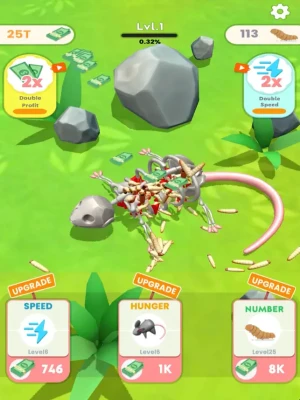
Latest Version
4.8
January 21, 2025
TapNation
Games
iOS
539.1 MB
0
Free
Report a Problem
More About Idle Maggots - Simulator Game
The Fascinating World of Maggots: Nature's Clean-Up Crew
Maggots, often viewed with disgust, play a crucial role in the ecosystem. These larvae, primarily from flies, are nature's efficient decomposers, breaking down organic matter and recycling nutrients back into the environment. In this article, we will explore the life cycle of maggots, their ecological importance, and even their potential benefits for humans.
Understanding Maggots: What Are They?
Maggots are the larval stage of certain fly species, most commonly the common housefly and the blowfly. They typically emerge from eggs laid on decaying organic material, such as dead animals or rotting food. These larvae are characterized by their soft, elongated bodies and lack of legs, making them highly efficient at wriggling through their environment.
The Life Cycle of Maggots
The life cycle of maggots is fascinating and consists of several stages:
- Egg Stage: Female flies lay hundreds of eggs on suitable organic material.
- Lava Stage: After a day or two, the eggs hatch into maggots, which begin to feed on the decaying matter.
- Pupal Stage: Once they have grown sufficiently, maggots will find a safe place to pupate, transforming into a pupa.
- Adult Stage: After a week or two, the adult fly emerges, ready to continue the cycle.
The Ecological Importance of Maggots
Maggots play a vital role in the ecosystem by aiding in decomposition. Here are some key benefits:
- Nutrient Recycling: By breaking down dead organic matter, maggots help return essential nutrients to the soil, promoting plant growth.
- Waste Reduction: They contribute to waste management by consuming decaying materials, which helps prevent the spread of disease.
- Food Source: Maggots serve as a food source for various animals, including birds and other insects, thus supporting the food chain.
Are Maggots Safe to Eat?
Interestingly, maggots are not just beneficial for the environment; they also have potential uses in human consumption. In some cultures, maggots are considered a delicacy and are consumed for their high protein content. Here are some points to consider:
- High Nutritional Value: Maggots are rich in protein, vitamins, and minerals, making them a nutritious food source.
- Alternative Protein Source: As the world faces a protein shortage, maggots could provide a sustainable alternative to traditional livestock.
- Food Safety: It is essential to ensure that maggots are sourced from clean, uncontaminated environments to avoid health risks.
Using Maggots in Medicine
Maggots have also found a place in modern medicine, particularly in wound care. This practice, known as maggot debridement therapy (MDT), involves using sterile maggots to clean wounds. Here’s how it works:
- Debridement: Maggots consume dead tissue, promoting faster healing and reducing the risk of infection.
- Antibacterial Properties: They secrete substances that help kill bacteria, further aiding in wound management.
- Cost-Effective: MDT is often more affordable than traditional surgical methods for wound care.
Conclusion: Embracing the Role of Maggots
While maggots may evoke feelings of disgust, their ecological and potential human benefits are undeniable. From their role in decomposition to their use in medicine and as a food source, maggots are an essential part of our ecosystem. By understanding and appreciating these fascinating creatures, we can better recognize their value in nature and even in our diets.
Next time you encounter maggots, consider their vital role in maintaining the balance of our environment and their potential benefits for humanity. Embracing the role of maggots can lead to innovative solutions for waste management, nutrition, and healthcare.
Rate the App
User Reviews
Popular Apps










Editor's Choice































